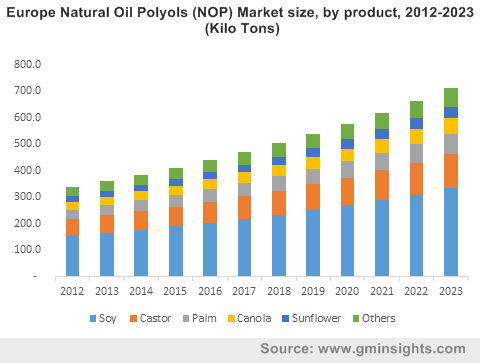Home > Chemicals & Materials > Specialty Chemicals > Custom Synthesis > Natural Oil Polyols (NOP) Market
Natural Oil Polyols (NOP) Market Size
- Report ID: GMI503
- Published Date: Jun 2016
- Report Format: PDF
Natural Oil Polyols Market Size
Natural Oil Polyols (NOP) Market size was over 18 million tons in 2015 and is forecast to grow at more than 7% CAGR up to 2023.

Biobased polyurethane (PU) demand was over 1600 tons in 2015 and projected to surpass 2600 tons by 2023, growing with estimated gains of 6.5% CAGR up to 2023. Increasing bio polymers application scope in various end use industries owing to its sustainable properties are key trending factors to drive global natural oil polyols market growth.
Major conventional PU manufacturers are preferring to shift towards utilizing eco-friendly products derived from biomass for product manufacturing. A number of biotechnology companieshave been collaborating with leading playes for technical know how for manufacturing bio based PU. Biomass based raw materials will help to curb carbon emissions and are expected to be economically sustainable which may positively influence durability & performance of PU.
Industry shift towards development of bio-based products in order to reduce dependency on petrochemicals may drive NOP market size. They are comparable in terms of longevity and sustainability when used as a substitute for petrochemical polyols. Polyurethane is expected to be sustainable and may positively impact performance and durability.
| Report Attribute | Details |
|---|---|
| Base Year: | 2015 |
| Forecast Period: | 2016 to 2023 |
| Historical Data for: | 2012 to 2015 |
| No. of Pages: | 76 |
| Tables, Charts & Figures: | 54 |
| Segments covered: | Product and Region |
Increasing application scope in automotive, construction and furniture industry to reduce conventional plastic usage are considered to favor NOP market size growth. Favorable government initiatives in order to reduce green house gases (GHG) emissionsmay positively infuece the demand. EPA and REACH compliances to promote environment friendly products pertaining to health and ecosystem safety are key promising factor to stimulate natural oil polyol demand.
Furthermore, the European Emission Standards (EES) is increasingly implying stringent regulations on vehicular emissions from tail pipe. The trend of continuous efforts to reduce vehicular emissions is anticipated to continue over the next few years. These emissions are highly influenced by the overall vehicle weight, which may be lowered by using bio-based materials to build the chassis of the vehicle.
Japanese Government’s Biomass Nippon Strategy post-adoption of the Kyoto Protocol has prompted companies such as Toyota and NEC to accelerate their R&D levels into bio-based plastics and to raise the bio-based content of their products. Toyota is planning to switch 20% of the plastics used in its vehicles to bio-sourced plastics by 2015 and expects bioplastics to help in its efforts to accomplish its company-wide goal of reductions in CO2 emissions. Diversification and growth of niche application segments such as food and cosmetics industry may fuel industry growth. Additionally, companies such as Vertellus and BioAmber have been investigating commercial viability of 100% bio-based polyols. Increasing R&D spending coupled with introduction of 100% bio-based NOP may provide lucrative opportunities to industry paticipants in near future.
Key raw materials, castor, soy, rapeseed, tall, cotton and sunflower oilseeds, are majorly used for NOP production. Rapeseed oil supply is challenged owing to growing demand from food and animal feed applications.Increasing scope of key raw materials for biofuels and industrial applications may create supply demand gapand impact the natural oil polyol market price trend.
